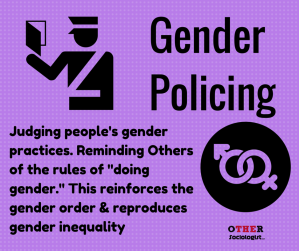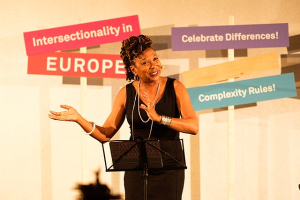9.3 Examining Interactions
We accomplish or “do” gender in our daily lives through our interactions with others and the ways in which we speak and think about gender, including the “rules” of gender that we may choose to follow or challenge. “Doing gender” is a phrase developed by sociologists Candice West and Don Zimmerman (1987). The phrase and concept continue to be built on by other scholars, but at the core, it refers to the idea that individuals perform gender based on the way that gender is socially constructed within their society. People are then held accountable by others for enacting gendered behaviors. It is true that we have agency to construct performances and engage in behaviors that are gender conforming or nonconforming. However, we are often held accountable for accomplishing certain “accepted” presentations of gender (West and Zimmerman 1987). Others expect people to engage in gendered performances and they contribute to why we think about gendered behavior as “natural.” In this section, you will learn more about how gender is socially constructed and learned through the process of socialization and the policing of behaviors. Some performances and embodiments of masculinity and femininity may be more highly valued in different contexts. Finally, we will explore how gender intersects with other identities, such as race, class and sexuality.
9.3.1 Social Construction of Gender
Gender is a constant part of who and what we are, how others treat us, and our general standing in society. Gender differences are visible in different aspects of behavior, emotions, relationships, and the organization of social institutions such as work and family. Often gender is divided into two major categories: women and men. The social construction of gender helps us understand how people produce differences between women and men’s characteristics and behavior. By understanding how gender is socially constructed, we are able to see how gender inequality is reproduced.
Patriarchy or a patriarchal society refers to an environment where characteristics associated with men and masculinity have more power and authority. In the evaluation of gender differences within a patriarchal society, women are ranked lower than men. Even valued characteristics of women such as empathy, nurturance, and care for others are ranked lower. Because men and boys are held in higher social regard than women and girls and are granted advantages and rights, gender differences produce gender inequality.
The social constructionist perspective allows us to understand changes in gendered practices and shows that social norms change over time. However, change does not come easily. Many foundational assumptions of the gendered social order are legitimated by religion, taught by education, upheld by mass media, and enforced by systems of social control. From a sociological perspective, we examine how trends change over time. Historically, all infants in the United States wore gowns which were typically white. After the invention of manufacturing and mass production, we saw the use of color but pink was identified as a strong masculine color while blue was associated with femininity (Paoletti 2012).
Some researchers suggest that the process of gender socialization begins in utero. During pregnancy after learning the sex, parents and guardians begin talking to their fetus in gendered ways (Martin 2003). Other researchers argue that children learn gender as infants. Between two and three years old, most children understand what sex they are and begin to identify the types of social norms they should participate in. Around this age, children develop preferences for same-sex playmates and have positive attitudes towards their own group (Martin and Ruble 2002; Shows and Gerstel 2009).
9.3.2 Socialization
Sociologists tend to view socialization as a lifelong process of learning and re-learning gendered expectations. Part of this learning process requires that we continually adjust to new contexts. As we age, travel, and experience new contexts we continue to learn about gender. This model of socialization explains how the “rules” of gender can change over time and how we are able to show agency, or personal control, in resisting gender rules.
The rules of gender are based on gender roles. Gender role refers to the expected role determined by an individual’s sex and the associated attitudes, behaviors, norms, and values. They are society’s concept of how women and men are expected to look and behave. These roles are based on the norms created by society. Traditionally, American culture associates masculine roles with strength, aggression, and dominance, while feminine roles are usually associated with passivity, nurturing, and subordination.
Gender socialization occurs through four major agents of socialization: family, education, peer groups, and mass media. Each of these reinforces gender roles by creating and maintaining expectations of what is normal for gender-specific behavior. Gender socialization also happens in other places, such as in religious institutions and at the workplace. Over time these agents lead people into a false sense that they are acting naturally rather than following a socially constructed role. In this section we will focus primarily on the role of families in socialization.
Family is the first agent of socialization we come into contact with. Evidence shows that parents socialize sons and daughters differently. Generally speaking, girls are given more permission to step outside of traditionally feminine roles (Coltrane and Adams 2004; Kimmel 2000; Raffaelli and Ontai 2004). However, the different ways that girls and boys are socialized tend to result in more privileges for boys. For instance, boys are allowed more autonomy and independence at an earlier age than daughters. They may be given fewer restrictions on appropriate clothing, dating habits, or curfews. Sons are also often free from cleaning or cooking and other household tasks that are considered feminine. Daughters are limited by their expectation to be obedient, passive, and nurturing. They are expected to take on many of the domestic responsibilities.
For example, something as simple as who is expected to participate in certain household chores can vary by gender. Figure 9.6 depicts a father and son maintaining the lawn, a household task that is typically completed a few times a month, while figure 9.7 shows a mother and daughter preparing a meal in the kitchen, a chore that is completed daily.


Children tend to absorb everything around them and quickly learn about gender stereotypes. They may align themselves to certain toys as they look for parental praise. However, children are active participants in their socialization and they may challenge gender expectations with what they know (or think they know). Children often actively participate in peer socialization when it comes to gender and help establish some “rules” about what is “right” through rigid policing (Messner 2000; Thorne 1993).
Even when parents set gender equality as a goal, there may be underlying indications of inequality. For example, boys may be asked to take out the garbage or perform other tasks that require strength or toughness, while girls may be asked to fold laundry or perform duties that require neatness and care. It has been found that fathers are firmer in their expectations for gender conformity than are mothers, and their expectations are stronger for sons than they are for daughters (Kimmel 2000). Parental socialization and normative expectations also vary along lines of social class, race, and ethnicity. African American families, for instance, are more likely than whites to model an egalitarian role structure for their children (Staples and Boulin Johnson 2004).
The drive to adhere to masculine and feminine gender roles continues later in life, in a tendency sometimes referred to as “occupational sorting” (Gerdeman 2019). Men tend to outnumber women in professions such as law enforcement, the military, and politics. Women tend to outnumber men in care-related occupations such as childcare, healthcare (even though the term “doctor” still conjures the image of a man), and social work. These occupational roles are examples of typical U.S. male and female behavior, derived from our culture’s traditions. Adherence to these roles demonstrates fulfillment of social expectations but not necessarily personal preference (Diamond 2002); sometimes, people work in a profession because of societal pressure and/or the opportunities afforded to them based on their gender.
Historically, women have had difficulty shedding the expectation that they cannot be a “good mother” and a “good worker” at the same time, which results in fewer opportunities and lower levels of pay (Ogden 2019). Generally, men do not share this difficulty. Since the assumed role of men as a fathers does not seem to conflict with their perceived work role, men who are fathers (or who are expected to become fathers) do not face the same barriers to employment or promotion (González 2019). This is sometimes referred to as the “motherhood penalty” versus the “fatherhood premium,” and is prevalent in many higher income countries (Bygren 2017).
9.3.3 Gender Policing
Socialization is a powerful force that is ongoing and occurs through many social institutions, such as education, mass media, and government. Considering that we have agency or freewill to behave as we want, you might be wondering why so many of us follow gender rules. Often, we follow gender rules out of habit, pleasure, and out of concern for how we will be viewed by others (Wade and Ferree 2015). Gender rules become part of our culture and we often participate in gendered practices unconsciously. In public spaces, men tend to take up more physical space compared to women. Figure 9.8 illustrates how the way we take up space in public is gendered. The man, with his legs spread wide apart appears to be taking up space on the woman’s seat.

We may receive pleasure when we enact forms of masculinity and femininity that are expected of us given our genders. Quinceañeras, high school proms, and weddings all provide us with opportunities to elaborately participate in gendered displays—most often suits or tuxedos for men and dresses or gowns for women. Finally, the reactions we receive from others regarding our gender performances shape our behavior. Members of a society are strongly invested in maintaining existing gender order, called gender policing. To maintain order, everyone is encouraged by society to remind people of the rules of “doing” gender (Zellavos 2014). We often expect people to conform to binary expressions which leads to gender inequality (figure 9.9). As you learned in Chapter 4, we are often expected to conform to social norms or normative behaviors. Our behaviors are often “policed” by our peers when they deviate from what is considered normal for a particular context.

Gender policing refers to the responses we receive when we violate gender rules. Typically breaking the rules can lead to negative attention. The negative reactions we receive from others act to reinforce the rules of gender. Consequences for violating gender rules can range from friendly, humorous teasing to more brutal and painful reactions.
Let’s look at an example from the research of American sociologist, Catherine Connell (2010) who applies West and Zimmerman’s concept of “doing gender” to see the extent to which gender can be undone in a professional context where transgender people work. She aims to study if transgender people challenge how gender is “done” through their jobs and work relationships. She conducted in-depth interviews with 19 transgender people. Five of the participants were in “stealth mode” in their workplace, meaning they did not identify themselves as a transgender person. Others said their gender was private and they had no desire to share this information with work colleagues. The other 14 participants had “come out” as transgender to work colleagues.
Connell finds that the male-to-female transgender people put a lot more work into doing gender after their transition. These transgender women talked about taking a lot more time and care in thinking about their outfits and in putting on make-up. The female-to-male transgender men reported the opposite. One transgender man talked about life being easier now, with less time spent on grooming. These people were acknowledging how “doing gender” happens. Society expects women to put a lot of time into their appearance, but the same expectation is not placed on men (and yes, this is changing, but the imbalance still places women under more scrutiny).
The participants in Connell’s study found that their colleagues were constantly giving them advice about how to do gender “properly” – how to dress, how to behave, how not to behave. Even though some of their colleagues were supportive, others expressed reservations about how gender reassignment might affect their employees. One computer programmer who transitioned from male to a woman says that her boss was afraid she wouldn’t be able to do programming as well. In this respect, the transgender women felt devalued in their workplace after their transition, and they adopted what they saw as masculine traits in order to gain back respect. This included being “more aggressive” during meetings. For example, raising one’s voice, banging on the table, and adopting behavior that appears “more assertive.”
Risks of nonconformity can be high. More than being perceived as “weird” or unpopular, we may lose the support of friends and family or even experience discrimination in the workplace based on our gender presentation. It might be difficult to imagine gender inequality today, considering the progress made by women’s rights movements over the past several decades. However, despite being a numerical majority, women still hold a minority position in society. This means that women (as well as others who are members of minority groups) hold less power and experience unequal treatment in society. For example, men are able to take up more physical space compared to women and are less likely to be interrupted when speaking.
Inequalities emerge through sexism, the belief that some individuals or groups are superior to others based on sex or gender. Sexism connects with the concepts of prejudice and discrimination. Prejudice refers to a set of strongly held beliefs or attitudes about the characteristics of a group that are not likely to change even when evidence challenges those beliefs. Prejudices are difficult to change as they are often rooted in stereotypes that are part of our shared culture. Discrimination refers to behaviors or actions that create unequal treatment for individuals or groups because of their statuses (e.g., age, beliefs, ethnicity, sex) by limiting access to social resources (e.g., education, housing, jobs, legal rights, loans, or political power). Prejudice and discrimination can be based on sexual orientation, gender expression, and gender identity which you will learn more about in Chapter 10.
9.3.3.1 Masculinity
Masculinity involves the performance of gender shaped by society’s expectations for men. At a young age, parents of boys express concern over their children’s participation in “feminine” activities such as wearing pink, dressing up in feminine attire, or wearing nail polish (Kane 2006). In Emily Kane’s research, outside of learning to cook and clean, parents assumed “feminine” behaviors were inappropriate for boys and often expressed distress by questioning why a particular behavior was occurring. Interestingly enough, parents who were open to gender nonconforming behavior still discouraged femininity as a way to protect their children from social disapproval. As this example illustrates, the fear of social disapproval stems from a culture that defines masculinity in opposition to femininity (figure 9.10). Boys and men are taught to avoid femininity or being perceived as feminine.

In her foundational text, Gender & Power, Connell (1987) introduces the idea that there are multiple masculinities. Forms of masculinity that are generally valued and perceived as socially acceptable in dominant culture can be extremely constraining. Hegemonic masculinity is the masculine ideal that is viewed as superior to any other kind of masculinity as well as any form of femininity (Connell 1987; Connell and Messerschmidt 2005). Characteristics and behaviors associated with this ideal standard of masculinity may change over time (Connell 1987, 1995). However, we continue to see an emphasis placed on masculinity that aligns with characteristics of independence, aggression, competition and toughness.
Extreme versions of hegemonic masculinity that conform to the more aggressive rules of masculinity are sometimes referred to as hypermasculinity (Wade and Ferree 2015). In our culture, hypermasculinity tends to glorify aggression that one might associate with action movies, video games, and even some athletic performances. In reality, men are not inherently violent – but hypermasculine performances of gender make some men’s violence, aggression, and anger seem normal.
Some scholars discuss an even more extreme form of hegemonic masculinity as toxic masculinity. The term toxic masculinity captures some of the cultural pressures placed on men to conform to hegemonic masculinity. Men may engage in risky behaviors to achieve the culturally approved standards of manhood. Psychologists argue that these standards of manhood take a negative toll on men’s mental and physical health (Iwamoto et al. 2018). Toxic masculinity can be found in both academic and popular culture contexts. Both generally depict a masculinity that exhibits toughness, rejects anything feminine, and prioritizes power and status (Thompson and Pleck 1986; Morin 2020).
While there is debate over how much new styles of masculinity challenge hegemonic masculinity, scholars agree that our constructions of masculinity fit into a larger issue of gender inequality (Connell and Messerschmidt 2005). Research on masculinities has explored a few different areas including: 1) various forms and styles of masculinity; 2) different ways scholars use the concept of hegemonic masculinity; 3) female masculinities; and 4) how power and masculinity intertwine through the lens of globalization. Some researchers argue that masculinity is no longer strictly defined against femininity. Instead the intersections of class and race create a new line of division. For example, the class-privileged, white “new man” of the 1990s may challenge traditional depictions of hegemonic masculinity. However, this “new man” is constructed against the “macho” masculine gender display of subordinated men of color who have less power and socioeconomic status (Hondagneu-Sotelo and Messner 1994). Instead of emphasizing power dynamics along the lines of gender, we see the ways that race and socioeconomic status play a role in constructing a masculine ideal.
The notion of a “new man” comes from what sociologist Tristen Bridges refers to as hybrid masculinities. Hybrid masculinities are created when subordinated styles and displays of gender are co-opted by men with privileged identities (Bridges 2014; Bridges and Pascoe 2014, 2018). For instance, men with class privilege may participate in personal grooming practices that are traditionally perceived as feminine as a way to enhance their positions of privilege with displays of metrosexual style (Barber 2016). Rather than undermining the unequal power relations embedded in hegemonic masculinity, Bridges and Pascoe (2018) argue that hybrid masculinities conceal systems of inequalities related to gender and sexuality.
9.3.3.2 Femininity
While men’s performances of doing gender are routinely subjected to gender policing, women often have more freedom and are sometimes rewarded for performances of masculinity. A “tomboy” (a girl who acts masculine) is usually regarded more positively than a “sissy” (a boy who acts feminine). Think back to Emily Kane’s research that we learned about in the masculinity section. Parents were nervous about boys’ performances of femininity and discouraged the practices, but expressed delight in their girls’gender nonconforming behavior and even encouraged participation in traditionally male activities such as T-ball, football, and using tools (Kane 2006:156-7). This does not mean that women are free of gender policing completely. Instead the approval reflects the way in which masculinity is perceived as more highly valued in a patriarchal society. Women are simply tapping into the characteristics that are already highly sought after and rewarded in their culture.
Women can benefit from participation in masculinity, but they must learn the right balance. Women engaging in what others consider too much masculinity will receive the same gender policing men who participate in a little femininity receive. The expectation that women learn to balance their interest in “masculine” activities and traits with a feminine gender performance is called the feminine apologetic (Wade and Ferree 2015). For example, women athletes often participate in the feminine apologetic such as making efforts to appear feminine, apologize for aggression, or mark themselves as heterosexual to counter their success in sports, an arena that is often considered masculine (Davis-Delano et al 2009). The strategy of using the feminine apologetic enables women to gain benefits that come with participation in masculinity without attracting violent gender policing (Hardy 2014).
When we examine power relations, there are some disadvantages to “doing” femininity. In dominant culture, many of the traits associated with femininity are largely devalued in society. Power is gendered and the current construction of femininity draws on traits that are passive and show deference to hegemonic masculinity. In other words, “doing” femininity also requires the embodiment of powerlessness to some extent.
In Gender & Power, Connell (1987) also spent some time theorizing femininity, particularly the concept of emphasized femininity. Emphasized femininity is “the pattern of femininity which is given most cultural and ideological support” (Connell 1987: 24). It is “defined around compliance with subordination and is oriented to accommodating the interests and desires of men” (Connell 1987:187). She argues that this version of femininity is a reaction to hegemonic masculinity, and although it has value, masculinity at large is still perceived as more highly valued. Originally, theories on femininity focused on it as a subordinated gender performance and did not expand on the ways that some forms of femininity have power over others. The limitations of this approach are evident when we consider femininity and its connections to hegemonic power relations (Hamilton et al 2019).
Sociologist Patricia Hill Collins (1990; 2004) extends Connell’s theorizing of femininity by incorporating an intersectional lens. She argues that hegemonic femininity is race-based, class-based, and gender-based. When women accomplish the ideals of femininity, they are contributing to oppression through what she refers to as the matrix of domination. Hegemonic femininities hold a powerful position in the matrix, resulting in some women receiving benefits over others (Hamiliton et al 2019). We will examine the concept of intersectionality more in the next section.
9.3.4 Intersectionality
A key idea that grew out of of the third-wave feminist movement (which you will learn more about in the section “Movements for Change: Feminim”)—and out of feminist analyses of how gender and race are socially constructed is intersectionality. As you learned in Chapter 2, intersectionality is the idea that inequalities produced by multiple and interconnected social characteristics can influence the life course of an individual or group. Intersectionality, then, suggests that we should view gender, race, class, or sexuality not as individual characteristics but as interconnected social situations.
This perspective allows us to appreciate the ways different social structures and aspects of our identities intersect. For example, intersectionality allows us to understand how a person’s identity and life experiences are shaped by racism, sexism, classism, and homophobia (among other systems of oppression). At the “intersection” of various social forces, we experience ways of being and moving about the world that differ from another person whose social location may be distinct from our own.
Intersectionality also examines how interlocking systems of power affect the most marginalized people in a society. From an intersectional perspective, multiple forms of discrimination combine and transform the experience of oppression. The purpose of using an intersectional lens is to understand how overlapping categories of identity change in combination with each other and how they impact individuals and institutions. The framework of intersectionality is essential to studying relations of privilege and power in efforts to promote social and political equity.
The theory of intersectionality was first articulated by Kimberlé Crenshaw, a lawyer and critical race theorist who was trying to understand how antidiscrimination law could fail to account for the way in which a black woman might be discriminated against (Crenshaw 1989). She developed the analogy of an “inter-section,” where racism and sexism meet, to help us understand and see the ways in which multiple aspects of our identities—and multiple social forces that helped to shape those identities—could impact us. Crenshaw invented the term intersectionality in 1989, and it was adopted in the years that followed by feminist scholars. In 2016 Crenshaw delivered a TED talk entitled, “The Urgency of Intersectionality.” More than thirty years later, the idea of intersectionality is still an urgent one.

For a nice visual to help you understand this complicated concept, check out this informative guide created by Miram Dobson with description by Zoe Stavri here: Intersectionality a fun guide [webpage]. In the next activity, “Pedagogical Element: Intersectionality,” you’ll have an opportunity to learn more about intersectionality from Kimberlé Crenshaw.
9.3.5 Activity: Intersectionality
In this short video, you will see an interview with Dr. Crenshaw at Lafayette College where she discusses intersectional feminism and the need for this approach.
Figure 9.12. Kimberlé Crenshaw Discusses ‘Intersectional Feminism’ [YouTube]
Please watch the Kimberlé Crenshaw Discusses ‘Intersectional Feminism’ [YouTube] and come back to answer the following questions:
- How does Dr. Crenshaw’s definition of intersectionality compare with your understanding?
- How does Dr. Crenshaw’s biography shape her understanding of gender and race?
- In what ways does the language of intersectionality offer tools to engage in social justice work?
9.3.6 Licenses and Attributions for Examining Interactions
“Examining Interactions” is original content by Jennifer Puentes and licensed under CC BY 4.0.
“Social Construction of Gender” is original content by Jennifer Puentes and licensed under CC BY 4.0.
“Socialization” paragraphs 3, 4, 7-9 are from “12.2 Gender and Gender Inequality” by Tonja R. Conerly, Kathleen Holmes, Asha Lal Tamang in Openstax Sociology 3e, which is licensed under CC BY 4.0. Access for free at https://openstax.org/books/introduction-sociology-3e/pages/12-2-gender-and-gender-inequality; edited for consistency, clarity, and brevity. All other content in this section is original content by Jennifer Puentes and licensed under CC BY 4.0.
Gender role definition from the Open Education Sociology Dictionary is licensed under CC BY-SA 4.0.
Figure 9.6. Photo by hose902. License: flickr CC BY-NC-ND 2.0.
Figure 9.7. Photo by Nenad Stojkovic. License: flickr CC BY 2.0.
“Gender Policing” paragraphs 4-6 from “Transgender Women’s Experiences of Gender Inequality at Work” by Zuleyka Zevallos in The Other Sociologist, which is license: CC BY-NC-ND 3.0. Edited for consistency and brevity; all other content in this section is original content by Jennifer Puentes and licensed under CC BY 4.0.
Figure 9.8. Photo by Peter Isotalo. License: CC BY-SA 4.0.
Figure 9.9. Photo by Zuleyka Zevallos. License: CC BY-NC-ND 3.0.
Figure 9.10. Photo by JeongMee Yoon with artist permission.
Discrimination definition from the Open Education Sociology Dictionary is licensed under CC BY-SA 4.0.
“Intersectionality” adapted from “Chapter 2: Key Perspectives” by Nadine T. Fernandez and Katie Nelson in Gendered Lives which is licensed under CC BY 4.0. Paragraphs 2-4 edited for consistency, clarity, and brevity. All other content in this section is original content by Jennifer Puentes and licensed under CC BY 4.0.
Intersectionality definition adapted from the Open Education Sociology Dictionary is licensed under CC BY-SA 4.0.
Figure 9.11. Photo by Mohamed Badarne – Heinrich-Böll-Stiftung from Berlin, Deutschland. License CC-BY-SA-4.0.
“Pedagogical Element: Intersectionality” and Figure 9.12 (screenshot) adapted from Kimberlé Crenshaw Discusses ‘Intersectional Feminism’ [YouTube] by Lafayette College. License Terms: Standard YouTube license.
